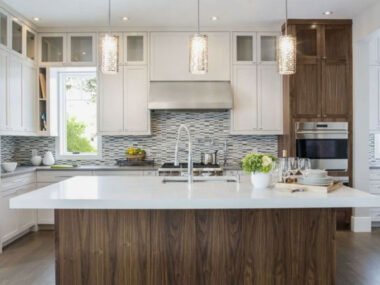Buying a fixer-upper can be exciting and overwhelming at the same time, notes Clockwork Property Management Solutions. You’re stepping into a house that has potential but likely needs some serious attention. The idea of turning a rough-around-the-edges property into your dream home is appealing, but where do you even start? Knowing what projects to focus on first can save you a lot of stress and help you settle in more quickly.
Let’s look at the most important home improvement projects to prioritize when you’re ready to take on this rewarding challenge.
Prioritize Safety and Structure
When it comes to a fixer-upper, safety should always come first. No matter how good the property looks on the surface, it’s crucial to dig deeper and make sure the house is safe and structurally sound. Start by hiring a professional to inspect the foundation, roof, plumbing, and electrical systems. These core elements of a home can cause serious problems down the line if not addressed right away. For example, a crack in the foundation might seem minor but could grow into a bigger issue over time.
Roof repairs or replacements are another area to tackle early on. A leaky or sagging roof can lead to water damage that affects the walls and floors inside. Similarly, old plumbing and outdated electrical wiring can pose risks, such as water leaks or electrical fires. While these repairs might not feel as exciting as redesigning a kitchen or painting walls, they’re the backbone of a safe and functional home.
If you’re buying a fixer-upper, having a clear budget is key. This is why mortgage preapproval helps. It gives you a clear understanding of how much you can afford, including room to handle immediate repairs like fixing structural issues or updating electrical systems. With a defined budget, you can prioritize these critical projects without overspending or feeling overwhelmed.
Improving Energy Efficiency
Once the structural and safety concerns are addressed, focusing on energy efficiency can help your home run more smoothly and save money on utility bills. Fixer-uppers are often older homes, and many of them lack proper insulation, have drafty windows, or use outdated appliances. These issues might not seem urgent, but they can lead to higher energy costs over time.
Start small by sealing any gaps around windows and doors to reduce drafts. Weather stripping and caulk are inexpensive and can make a noticeable difference. If the windows are old and beyond repair, upgrading to energy-efficient models can be a great investment. They help with heating and cooling and also improve noise insulation, which can be a bonus if you’re in a busy area.
Insulation is another area to check. Many older homes have insufficient or worn-out insulation, especially in attics and crawl spaces. Adding or replacing insulation can make your home more comfortable and reduce heating and cooling expenses. These improvements might not be the most visible, but they’re practical and can make the house more livable as you work on other projects.
Key Interior Updates
After addressing the essentials, it’s time to focus on making the house feel like home. Start with simple projects that have a big impact on comfort and appearance. A fresh coat of paint can do wonders for outdated or dingy walls. Choose light, neutral colors to brighten the space and make it feel larger.
If the flooring is worn out or damaged, replacing it should be high on your list. Hardwood floors can often be refinished to restore their original beauty, while old carpets might need to be replaced entirely. If you’re on a budget, laminate or vinyl flooring, options can give you a polished look without the high cost.
Focus on key rooms first. The kitchen and bathroom are the most used spaces in any home, so it makes sense to prioritize updates there. You don’t need to go for a full remodel right away; simple changes like replacing faucets, updating cabinet hardware, or adding a backsplash can make a big difference.
Addressing Curb Appeal
First impressions matter, and this holds true for your home as well. While you might spend most of your time focusing on the inside, don’t neglect the exterior. Projects that boost curb appeal can make your home more welcoming and even increase its value.
Start with basic landscaping. Trim overgrown bushes, mow the lawn, and plant some flowers or shrubs to add color and life to the yard. If the driveway has cracks or uneven surfaces, repairing or resurfacing it can instantly improve the look of your property.
If the exterior of the house looks tired, a fresh coat of paint can make it stand out. Choose a color that complements the home’s style and fits in with the neighborhood. Replacing old or damaged gutters, fixing broken shutters, and adding new house numbers can also give the house a more polished look.
Lighting is another small but impactful project. Adding outdoor lights along walkways, porches, or patios not only improves safety but also creates a more inviting atmosphere. Solar-powered lights are a great option if you’re looking for an easy installation.
Planning for the Long Term
Fixer-uppers are all about taking things step by step. While it’s tempting to dive into every project at once, prioritizing and pacing yourself will help you avoid feeling overwhelmed. Once you’ve handled the immediate repairs and updates, start thinking about the bigger picture. What do you want your home to look like in five or ten years?
Bigger projects, such as a full kitchen remodel, adding a bathroom, or building an outdoor deck, can be completed later when you’re ready. Consider your budget and how you plan to use the space when creating a timeline for these larger renovations. Breaking these projects into smaller phases can make them feel more manageable.
It’s also a good idea to look for inspiration during this time. Browse magazines, visit open houses, or look online for ideas that fit your style and vision. Having a clear plan can save you time and money when you’re ready to tackle these larger projects.
Buying a fixer-upper is a big commitment, but it’s also an opportunity to create something that truly feels like yours. By starting with safety and structure, improving energy efficiency, making key updates, and planning for the future, you’ll be well on your way to transforming your house into a home you love.
With thoughtful planning and patience, you’ll tackle each project one by one and enjoy the process of bringing your vision to life.










